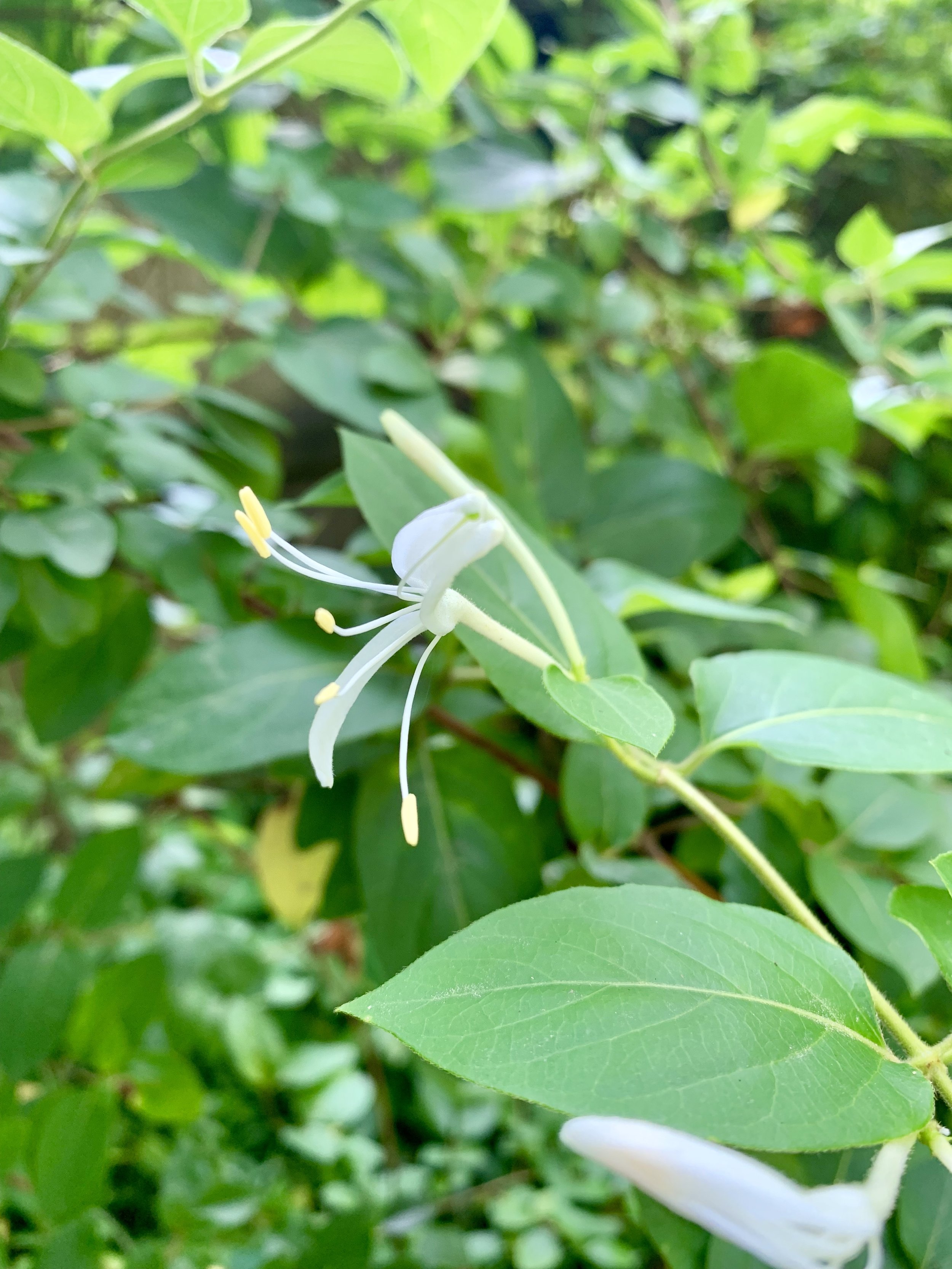While Southerners often claim honeysuckle as “ours,” there are actually many species that thrive all over the United States. But the variety most common in our region, Japanese honeysuckle, is the one that says “summer’s coming!” with its delicate white (that soon turn butter-yellow) blooms on vines that twist around tree trunks and tumble up and over backyard fences. Its tubular flowers look like spent party horns, and while they’re small, their sweet scent is thick and heady. And, each one has a surprise inside: The tiny drop of glistening nectar hanging suspended from the thread-like pistel once it’s pulled away from the petals is a treat simple and pure. As it melts on my tongue, it creates a sugar-laden second that transports me straight back to childhood.
When we lived in North Carolina, a neighbor a few years older taught me how to pinch off a small piece of a honeysuckle blossom’s backside, slowly and carefully slide the slim, white rod out of its center and get ready to “suck the syrup” as soon as I saw the bubble of moisture. When honeysuckle was at its height, we’d tiptoe into her kitchen, snag a big wooden bowl off the counter and take it with us as we walked up and down our neighborhood streets, picking honeysuckle flowers and putting them in the bowl. When it was filled, we’d head back to her house, sit on her porch and suck syrup until there wasn’t a bit left. This memory makes honeysuckle one of my favorite plants. But my admiration is not shared by all.
When Southerners complain about a vine that quickly consumes pretty much any outdoor space, overwhelming and often obliterating anything and everything in its path, kudzu is usually the plant we’re cursing. But honeysuckle is every bit as profuse and can be just as prolific. It is invasive and can cause gardeners a good bit of hassle and heartburn. Its relentless growth can smother and strangle the other shrubs and even trees that it covers. It’s actually such an issue in some parts of the country that the sale of the plant has been banned.
My mother might vote for a honeysuckle ban if it ever appeared on the ballot in Alabama. While she loves the flowers’ sweet scent, she’s no fan of the vine. It’s a weed of the worst kind, one that will quickly take over a yard, going and growing wherever it pleases. And my mom has developed a passionate personal vendetta against weeds.
As much as I enjoy honeysuckle, I know it’s hardy and extremely tough to get rid of, so I’ve taken great pleasure watching my mom battle this enemy. She’s soft-spoken and generally mild mannered, but put her within a hundred yards of honeysuckle, and she transforms to a horticulture super hero.
Garden gloves are slipped on and pulled down tight. Fingers are flexed. Sleeves are rolled up. Her gaze goes steely. And her gait is the determined walk of someone intent on completing a righteous task. She examines the offending vine, looking for the right spot to attack. When she finds it, she springs into action, grabbing and tugging, yanking and pulling, her teeth locked in a stubborn grimace. When at last the strong, sinewy vine gives up and comes loose, she laughs with delight. Seeing a honeysuckle vine submit to her will brings my mother such joy that I’ve even helped her before, killing something I love for someone I love much, much more.
In my own yard, I let the honeysuckle have its way. It’s currently blanketing the fence at the far corner of my backyard and crawling up a huge old oak. I often spend a few moments drinking in its familiar, soothing perfume before picking just a few flowers and stealing their honeyed liquid.
My mom has often advised me to get rid of it, reminding me it will eventually kill other plants. I’ve thus far ignored that advice. Maybe one day, when and if my vines take down some other botanical I’m fond of, I’ll let her at them, but for now, honeysuckle is safe with me.
Honeysuckle Sorbet
I used the recipe to make a granita instead of sorbet. It lacks the sorbet’s smooth texture, but it has the same scent-sasational flavor.
Not interested in sucking on a flower? You can still enjoy eating honeysuckle via this sorbet. Though I roughly halved it (and forgot the lemon juice, whoops!), all credit for this recipe goes to chef Bill Smith, recently retired from Crook’s Corner, a good eats institution in Chapel Hill, North Carolina. Find the original version and a little more info about chef Smith in this Garden & Gun article.
INGREDIENTS
Honeysuckle Water
3 cups cold water
2 cups honeysuckle blossoms
Simple Syrup
1/2 cup water
1 cup sugar
teeny pinch of cinnamon
Method
Soak blossoms in the water in the refrigerator overnight or up to 24 hours. In the meantime, make the simple syrup by mixing the sugar and water in saucepan and bringing to a boil. Simmer for a few minutes (until the sugar is all dissolved). Let cool. Refrigerate until use. Mix the honeysuckle water with the simple syrup. Put the mixture into your ice cream maker and follow its instructions.


